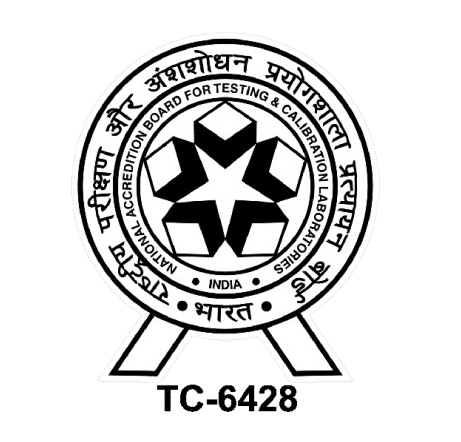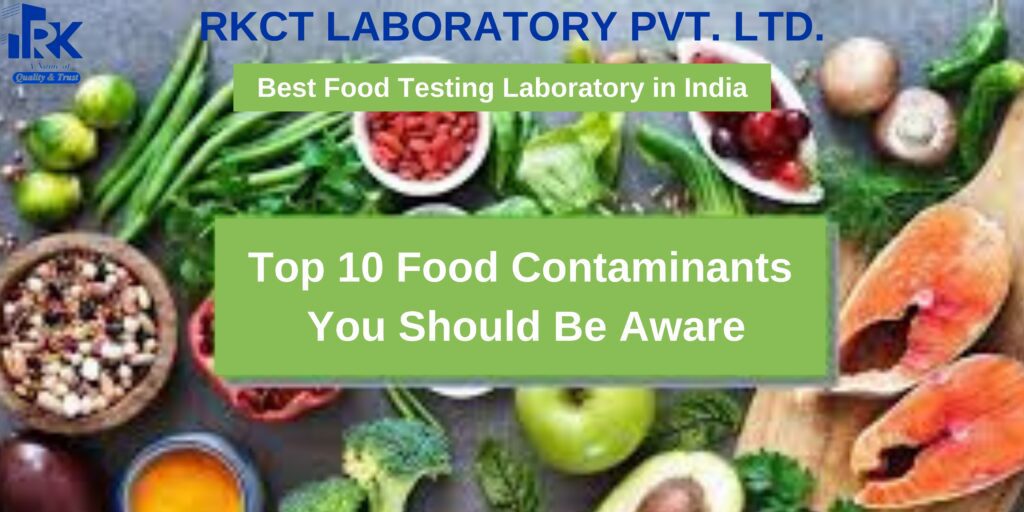Food safety is a major concern in India due to the presence of harmful contaminants in various food products. Contaminated food can cause serious health issues, including food poisoning, long-term diseases, and even organ damage. The RKCT Laboratory, one of the best food testing laboratories in India, ensures that food products comply with Indian Standards (IS codes) and are safe for consumption.
This blog will highlight the top 10 food contaminants, how they affect health, and how RKCT Laboratory helps in testing and preventing them.
What Are Food Contaminants?
Food contaminants are harmful substances that enter food products during production, processing, or storage. These can be:
🔹 Chemical Contaminants – Pesticides, heavy metals, preservatives.
🔹 Microbiological Contaminants – Bacteria, fungi, viruses.
🔹 Physical Contaminants – Plastic, glass, metal particles.
🔹 Adulterants – Artificial colors, non-edible oils, starch, etc.
Top 10 Food Contaminants in India – Sources, Risks & Testing Standards
1. Pesticide Residues
What Are They?
Pesticide residues are chemicals used to protect crops from pests, weeds, and diseases. However, these chemicals often remain on food items after harvesting and can pose serious health risks.
Common Sources:
✔️ Fruits (apples, grapes, mangoes)
✔️ Vegetables (tomatoes, spinach, cauliflower)
✔️ Grains (wheat, rice, pulses)
Health Risks:
🚨 Short-term effects: Nausea, dizziness, headaches
🚨 Long-term effects: Cancer, hormonal imbalances, nerve disorders
Testing Standard:
🔬 IS 16072:2013 – Guidelines for testing pesticide residues in food products
Detection Method:
✔️ Gas Chromatography (GC-MS/MS) & Liquid Chromatography (LC-MS/MS) for accurate pesticide analysis
- Heavy Metals (Lead, Mercury, Arsenic, Cadmium)
What Are They?
Heavy metals are toxic elements that enter food due to industrial pollution, contaminated water, and soil.
Common Sources:
✔️ Lead (Pb): Contaminated water, leafy vegetables
✔️ Mercury (Hg): Seafood (fish, shellfish)
✔️ Arsenic (As): Rice, groundwater
✔️ Cadmium (Cd): Leafy greens, cereals
Health Risks:
🚨 Lead: Brain damage, anemia, learning disabilities
🚨 Mercury: Kidney failure, neurological disorders
🚨 Arsenic: Skin diseases, cancer
🚨 Cadmium: Liver and kidney damage
Testing Standard:
🔬 IS 16471:2017 – Testing guidelines for heavy metal contamination in food and water
Detection Method:
✔️ Atomic Absorption Spectroscopy (AAS)
✔️ Inductively Coupled Plasma Mass Spectrometry (ICP-MS)
- Aflatoxins (Fungal Toxins)
What Are They?
Aflatoxins are toxic compounds produced by fungi (Aspergillus species) that grow in warm, humid conditions.
Common Sources:
✔️ Nuts (peanuts, almonds, cashews)
✔️ Cereals (wheat, rice, corn, barley)
✔️ Dried fruits, spices, milk
Health Risks:
🚨 Short-term effects: Vomiting, abdominal pain
🚨 Long-term effects: Liver cancer, immune suppression
Testing Standard:
🔬 IS 5887:2020 – Standard for aflatoxin detection in food
Detection Method:
✔️ High-Performance Liquid Chromatography (HPLC)
✔️ ELISA test kits for rapid detection
4. Bacterial Contaminants (Salmonella, E. coli, Listeria, etc.)
What Are They?
Pathogenic bacteria cause foodborne diseases and thrive due to poor hygiene, improper storage, and contaminated water.
Common Sources:
✔️ Salmonella: Raw meat, eggs, dairy
✔️ E. coli: Contaminated water, uncooked vegetables
✔️ Listeria: Unpasteurized dairy, seafood
Health Risks:
🚨 Diarrhea, vomiting, fever, food poisoning
🚨 Severe cases can cause kidney failure & death
Testing Standard:
🔬 IS 15174:2021 – Microbiological safety standards for food
Detection Method:
✔️ Culture-based microbiological testing
✔️ Polymerase Chain Reaction (PCR) for DNA-based bacterial detection
5. Artificial Food Colors & Preservatives
What Are They?
Synthetic food colors & preservatives are chemicals added to enhance the appearance and shelf-life of food. Some are toxic and banned in India.
Common Sources:
✔️ Bright-colored sweets, cold drinks, sauces
✔️ Canned foods, pickles, packaged snacks
Harmful Colors & Preservatives to Avoid:
🚨 Rhodamine B: Cancer risk
🚨 Sudan Red: Liver & kidney damage
🚨 Sodium Benzoate & Sorbic Acid: Allergies, hyperactivity in children
Testing Standard:
🔬 IS 2491:1983 – Food additives & coloring agents standard
Detection Method:
✔️ Spectrophotometric analysis
✔️ Chromatographic separation techniques
6. Plastic & Microplastic Contamination
What Are They?
Plastic contaminants enter food through packaging materials and polluted water. Microplastics are tiny plastic particles that cause serious health problems.
Common Sources:
✔️ Bottled water, seafood
✔️ Tea bags, plastic-packaged foods
Health Risks:
🚨 Endocrine disruption, reproductive disorders
Testing Standard:
🔬 IS 10500:2012 – Microplastic contamination in drinking water
Detection Method:
✔️ Fourier Transform Infrared Spectroscopy (FTIR)
✔️ Raman Spectroscopy
7. Antibiotic Residues
What Are They?
Antibiotics used in livestock and poultry farming stay in meat and milk products, leading to antibiotic resistance.
Common Sources:
✔️ Poultry, meat, dairy, seafood
Health Risks:
🚨 Weak immune system, antibiotic resistance, gut infections
Testing Standard:
🔬 IS 5403:1999 – Standards for antibiotic residue testing
Detection Method:
✔️ Liquid Chromatography (LC-MS/MS)
8. Adulteration with Cheap Substitutes
What Are They?
Food adulteration involves mixing inferior substances to increase profit, often illegally.
Common Sources & Adulterants:
✔️ Milk: Starch, detergent
✔️ Ghee: Vanaspati
✔️ Honey: Glucose syrup
Health Risks:
🚨 Digestive issues, food poisoning, toxicity
Testing Standard:
🔬 IS 10226:1982 – Food purity standards
Detection Method:
✔️ Chemical reaction tests
✔️ Chromatography for component separation
9. High Sodium & MSG (Monosodium Glutamate)
What Are They?
MSG is an artificial flavor enhancer found in processed foods.
Common Sources:
✔️ Instant noodles, chips, frozen meals
Health Risks:
🚨 High blood pressure, obesity, heart disease
Testing Standard:
🔬 IS 16072:2013 – Safe sodium limits in food
Detection Method:
✔️ Ion Chromatography (IC)
10. Expired & Spoiled Food Contaminants
What Are They?
Food stored for too long loses nutrients and accumulates harmful bacteria and mold.
Common Sources:
✔️ Stored grains, dairy, expired packaged food
Health Risks:
🚨 Diarrhea, vomiting, food poisoning
Testing Standard:
🔬 IS 16471:2017 – Food shelf-life standards
Detection Method:
✔️ Microbial spoilage analysis
Why Choose RKCT Laboratory for Food Testing?
✅ IS-Standard Testing – We strictly follow Indian Standards (IS codes).
✅ Advanced Equipment – Latest technology for accurate results.
✅ Expert Scientists – Highly skilled professionals ensure food safety.
✅ Fast & Reliable Reports – Quick turnaround time.
✅ Affordable Services – Cost-effective testing for manufacturers & consumers.
Conclusion
Ensuring food safety is crucial to protect health and maintain quality standards. RKCT Laboratory, the best food testing laboratory in India, follows Indian Standards (IS codes) to detect and eliminate harmful contaminants.
If you’re looking for trusted and certified food testing services, contact RKCT Laboratory today!
📞 Call Now for Expert Food Testing Services! 🚀
Need Help?
FAQs
Lorem ipsum dolor sit amet, consectetur adipiscing elit.
Mauris eros dolor pellentesque sed luctus dapibus lobortis orci.
1. Why is food contamination dangerous?
✅ Food contamination can lead to serious health issues like food poisoning, cancer, and organ damage.
2. How do I know if my food is contaminated?
✅ Contaminated food may have a bad smell, unusual texture, or cause sickness. Lab testing is the best way to confirm safety.
3. Can food testing detect pesticides and chemicals?
✅ Yes, RKCT Laboratory uses IS-approved methods to detect pesticides, preservatives, and chemicals in food.
4. How often should food manufacturers test their products?
✅ Regular testing is essential to comply with FSSAI & IS regulations and ensure safe food production.
5. Where can I get food testing services in India?
✅ RKCT Laboratory provides comprehensive food testing services across India for all types of food contaminants.




